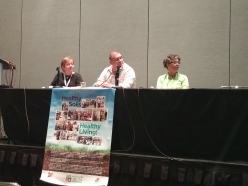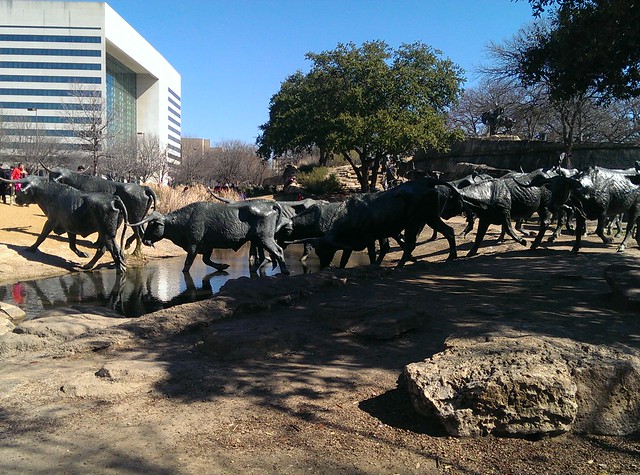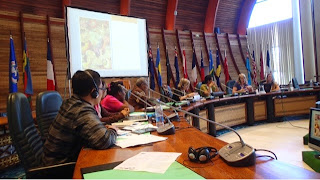The Designing Libraries for the 21st Century conference held in Calgary, Canada in September 2016 was attended by Margaret Mellinger, Beth Filar Williams and Victoria Heiduschke. It included a pre-conference day on Learning Spaces and one on Data Visualization.
Overall key takeaways:
- All space design must be purposeful and intentional
- When doing even minor redesigns of space it’s most helpful to bring in outside consultants to help with the process and planning

The Learning Spaces pre-conference was held in the brand new Taylor Institute for Teaching and Learning (TITL)
Key Highlights:
- When designing spaces think first of the intention and purpose, not the furniture and arrangement. It’s all about the LEARNING–not the things in the space. What are the gaps on campus? Should be intentional, but note duplicating a space might really have a new intention or group or bring together multiple disciplines as like the real world.
- Foundational design characteristics to consider
Flexibility– Versatility such as all movable furniture so the space can rearragned for a new intent. For example, the TITL had a large lecture hall room which could be pushed back like bleachers to make any sort of active learning classroom- Transparency such as rooms with glass walls or open spaces to see learning in the process
- Collaboration
- Technology – the backbone- a critical aspect for
 all space. For example, TITL has the tech boxes throughout the space in the floor.
all space. For example, TITL has the tech boxes throughout the space in the floor.
- System architect – create blueprints for students workflow and instructors workflow while in the design process. (hint: this is service design thinking)
Core values of design concepts within a space and with partners:
- Intention —Everyone need think “how does my work contribute positively to student learning?”
- Think about regular practitioners, and the occasional practitioners, and the students…but also the consumer – those who will not do these big research projects, but chat, connect with others on campus, etc.
- Offer “Seeding SoTL” initiatives – (http://www.ucalgary.ca/taylorinstitute/seed-SoTL) – form a reading group, a teaching square, a community of practice, hosts a small unconference. Note: often instructors learn in small, informal conversations, than big former presentation settings.
- Flexibility/Versatility — Adapt to specific context and recognize that quality and effectiveness are informed by these contexts: existing experience, local context, knowledge catalysts (networkers and connectors) … and connect these networks and groups by providing resources and meaningful opportunities to connect these networks.
- Transparency — Share process and products with other out of respect, trust, and desire to contribute to knowledge growth. EX: the teaching academy (highlighted on the wall of honor) goal is to make teaching and learning open and shared. EX: open classroom week, where 20 instructors allowed over 200 observers to come to their classroom, to see the real authentic learning and teaching in process – not for telling these people what they did wrong but to simply observe. Teaching is tough, let’s share with each other.

- At VCU they classify their spaces into three areas: Destination space, study space and campground spaces..
Ideas to consider at OSULP:
- Photo diary interviews with our users. Here is an example: Understanding user in our Learning spaces, by Susan Beatty U of Calgary Studying students on their perceptions of library learning spaces. Why do they choose specific spaces to learn? They learn in different spaces and different ways. Have them photograph specific types of spaces, then interviewed them about photos such as “what are the features, what would help you learn, how top you use them” Recruited by asking “do you study in the library?” gave $25 gift card for the interview. Used social media to recruit along with posters. Hoped for 20 and got 50 interested, all types and levels. Results: learning awareness, even if they did not use the space they knew what it was best used for. (See my photos) Though she didn’t ask the value of the library, they told her — functionality, they want to be able to move to various spaces and access various services, in one place….also a sense of belonging or Ownership, and key to academic success. (see her slides for details) Also mood and motivation – comfort zone, not necessity comfy seats, but safe, space to be open to learn and achieve their goals.
- Student Videos: Ask students to a 1-5 min video on why they love the library. Give a prize to winner. Use these to show the trustees! (Purdue libraries); and make use of stairwells, for quotes, poetry, of students or former students, or art by students; helps students make this space, their space. Could be a great partnership with SMS.
- Visiting Libraries: Bring a student or multiple students with you when visiting other libraries for ideas on creating intentional spaces.

The Data Visualization pre-conference was help in the Taylor Family Digital Library (http://tfdl.ucalgary.ca/faqs)
Key Insights | application to OSULP:
- Because screen technology is changing so quickly, Edmonton Public Library will wait until 2019 to finalize hardware decisions.
- The programming that will happen in the space is more important than the space – it is also the more difficult part. While we have been talking with faculty about the data vis space, we also need to interview students, analyze curricula and frame the need for this space in broader digital and data literacy terms.
- What I liked about the Auraria Library was the examples of low cost applications that could be employed and displayed when curriculum or research based content was not available. Good for keeping content fresh and for attracting tour groups to interact with the wall.
- Hire a part-time, dedicated project manager (outside of the contractors, vendors, facilities people) – someone to represent the libraries’ interest and schedule.
- Form a group to prior to installation
- SANDBOX VR in public spaces – this would be a fabulous event for us to do with Ecampus people (NCSU is doing this)
Closing Panel: Rethinking the organization as you redesign space
Organizational Change: For major renovations or organization structure changes, Murray-Rust suggest these important lessons:
- Actively manage and socialize change – protect people’s self esteem and minimize fear and anxiety.
- Seek out and accept outside help. There are reasons for change and outsiders can help
- Offered Mindfulness training for staff 12 – 1:30 once a week.
University of Rochester New Service Model in Old Spaces
- New space includes: New desk called “Q&I” (questions and information); Computing and Tech “Sandbar” ; Very few fixed workstations; Research consults throughout the space “YOU ARE THE REFERENCE DESK” ; Popup programming; 3 digital screens
- Process for organizational change over 3 years: started with strategic plan and a facilities master plan; Created a series of working groups to arrive at a service models for access and reference (hired Brightspot for this); THEN did the space design
- Key points: staff drove the changes, which were a series of incremental ones – renaming spaces, creating new services, making service desks smaller
Important Lessons:
- Gained important lessons from Leading Change by John Kotter.
- Everyone has to see themselves in their roles and understand the narrative.
- Moved from “my library” to “our library” learned to work in groups (not always in consensus – there are gradients)
University of British Columbia, Barber Learning Center
- How does the organization respond to space changes and when are spaces no longer viable? They consolidated a bunch of libraries and service points.
- Process for organizational change was a “seismic shift” There was a strong initial vision, but they also have staff who work in community-driven ways. They have a governance council.
- Staff organized a community of practice to take charge of their own development and this was particularly effective.
Important Lessons:
- If you are the person with the drawings, you must go beyond communicating change and socialize change.
- Make your first teams as big as possible – people support what they help build
- Imagine the project as a chapter in the library’s story






































 They created the OWRC (
They created the OWRC (






